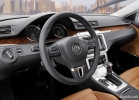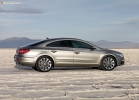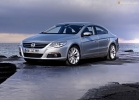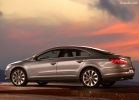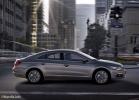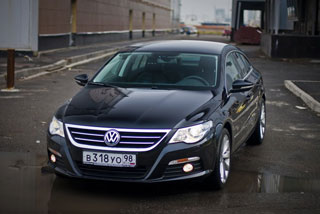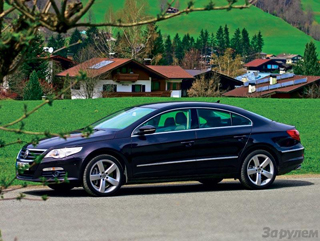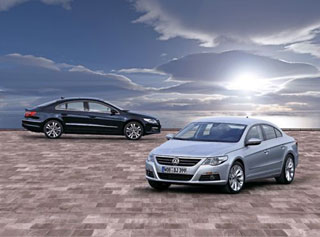Volkswagen Passat CC test drive since 2009 sedan
Folk style
We get used to the new appearance of the most beautiful Volkswagen.In 2008, the Volkswagen brand decided on a risky step and released her first emotional vehicle VW Passat CC. A four -door compartment, or Lifestail -Sedan, or a passat for originals - you can call it as you like, but it does not change the essence: the company that has always been proud of its traditions suddenly launched a completely informal car into the series.
And then it turned out that Volkswagen clients, it turns out, had long been waiting for such a car: for three years, Passat CC was dispersed by a circulation of 320 thousand cars, twice as much than the VW marketers planned. Even in conservative Russia, every tenth of the sold Passat had a SS wool on the trunk. Perhaps that is why Passat CC has remained the only Volkswagen model with a design from the past, still Gunakov era - with swollen eyes -wrappers and a powerful radiator grate panel?
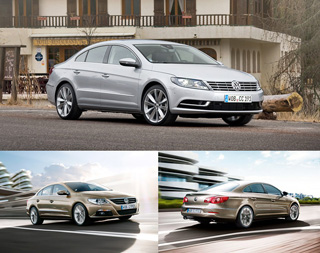
VW Passat CC (in the photo below) very quickly received the folk title of the most beautiful Volkswagen, and then also a few prestigious design awards. Unfortunately, the new TsE-T-TsE is no longer so far out of the VW corporate style.
But now the compliance with the general cultural style is one hundred percent: characteristic angular headlights with the LED bovery U in the case, a horizontal grill that occupies the entire space between the headlights, the lights in the rear headlights and many, many chromiums. The updated Passat CC resembles all Volkswagen at the same time, but especially the seventh Passat Sedan and the flagship VW Phaeton. Which, however, is logical, because the main task of the current facelift, in addition to standardization of appearance, is the technical unification of two passats, ordinary and c -ce.
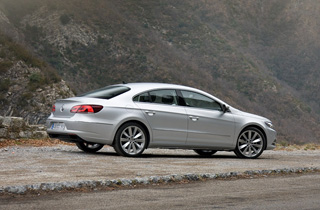
The VW Passat CC profile is very good. Especially with new rear lights
What does it mean?
This means that now Passat SS has received the same set of smart electronics as the Passat and Jetta sedans debut last year: adaptive cruise control and adaptive headlight, a system of recognition of road signs, a system for controlling blind zones and maintaining a row of movement. Moreover, the Side Assist Plus (the one that controls the cars in the dead zone) in case of danger not only blinks with the LED in the hull of the rear -view mirror, but also creates an additional force on the steering wheel, hinting that the driver is not worth it in the neighboring row. Lane Assist, in turn, can independently adjust the trajectory of movement with short steering turns. It looks especially impressive from the side when the driver releases the steering wheel on a gentle arc
A renewed automatic parking worker with both parallel and perpendicular parking skills will appear on the TSE-TEC, and even the trunk cover opening the lid of the leg as on the Passat sedan. The latter, however, still works through it and does not cause much joy: it is still necessary to close the lid with your hands.
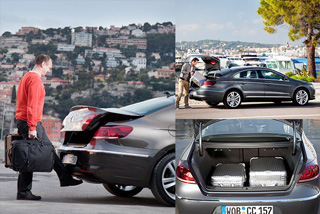
Anyone who has a key to the car can open the trunk lid with a kick with a kick: for this you need to/wave your foot under the rear bumper. The trunk of CC, by the way, is a rather big 532 liter with raised back seats. You can add them in a 2/3 proportion.
Changes in the cabin minimal tidy with white backlight and color display of the on-board computer (on expensive versions), turnouts instead of an emergency button on the front panel and a new climate control unit, which now differs from that used on an ordinary sedan. But the quality of materials and execution is still at the highest level: aluminum is really aluminum, and the tree is a tree, albeit under a thick layer of varnish. A two -tone salon with contrasting inserts on the seats and panels of the doors is especially good.
Interior
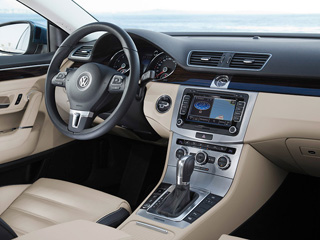
The All -Folkswagen multimedia system cannot boast of neither advanced navigation nor the ability to be beautifully interacting with external multimedia devices. But in a car with such an appearance, of course, I would like to see a more exquisite salon.
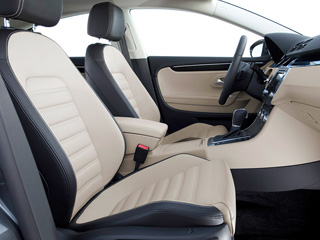
The front seats look great and the body hold well with their unobtrusive, but very confident support in the backs and hips, and a successful profile. You can order a built -in massager, however, a little stupid, and ventilation, which was also at the predecessor.
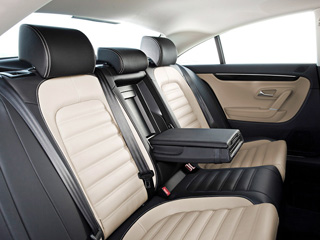
The rear sofa is best taken in the basic version for two, with a comfortable niche in the middle. The three of the back will still not be very convenient. Passengers over the head of the passengers are there, but this does not cause discomfort. However, on cars with a panoramic hatch, the ceiling will be slightly lower.
Other innovations of the restyled Passat CC, in fact, does not have a line of engines remained the same: a 1.8-liter 160-horsepower engine is considered to be basic, which is available in Russia in a version of the version, a two-liter turbo engine with a capacity of 210 horsepower is followed, two diesel 2.0 (140 and 170 forces), of which we will get a more powerful option, and at the top of the range of the all-wheel drive 300-horsepower CE-T-E-T-E-CE with the V6 engine and all-wheel drive already in the database. True, a couple of years ago, the top-end version in the Russian market did not take root due to the high cost, but after restyling it will reappear!
The basic motor is equipped with either a mechanical gearbox or a seven -speed DSG robot with dry clutches, and more powerful Passat CC variants in Russia will be available only with a hardy six -speed preselly. It is interesting that in the European Ts-Tse market with any of the diesel engines, a little later it will be possible to order with all-wheel drive transmission (Haldex coupling in the rear wheels), but the Russian prospects for such cars are not yet clear.
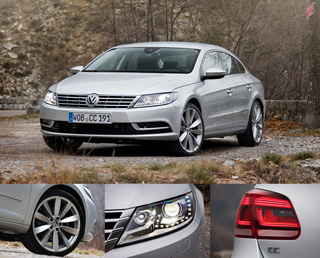
Passat CC is interesting in details: beautiful 19-inch wheels with knitting needles resembling turbine blades, an interesting design of head headlights, juicy colors of the rear lights with lights. But the silver wings in the front bumper is already superfluous.
Something choice of engines in Russia is small
And there is. The most suitable Passat CC option in spirit and dynamics is a two -liter gasoline engine with a turbocharger and a DSG robot. A magnificent motor with a pleasant traction in the entire speed range and excellent elasticity. In a sports mode, a six-speed pre-sequent transmission always holds the necessary transmission ready, allowing you to dynamically accelerate from almost any speed, and in the drive the box changes the steps quickly and almost imperceptibly, although it thinks a little if necessary to drop 2-3 gears immediately.
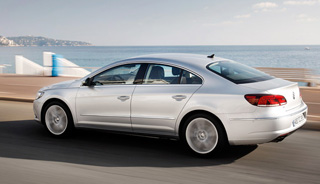
Passat CC with a two -liter turbo engine accelerates to one hundred kilometers per hour in 7.8 seconds, 0.2 seconds more slowly than a regular sedan, despite a slightly smaller mass. However, this is still the second in the dynamics of the CE-T-E-T-GAM in the gamut faster only the version with the V6, which is gaining the first hundred in an impressive 5.5 seconds.
The chassis is pleasantly neutral, and with active shock absorbers also universal. In the normal suspension mode, the Passat CC rolls with the confidence of the business sedan, in the sports is slightly clamped, reducing the rolls and exacerbating the reaction to the rotation of the steering wheel and move the gas pedal, in a comfortable good copes with cracks and uneven patches on the asphalt. Moreover, all three modes on the c-c-cie really work! They differ in settings, and they really want to play from time to time: turn on the sport before leaving for a winding road or comfort before the repaired highway.
And the most pleasant option is normal. Ideal for everyday driving: moderately collected and quite comfortable. The suspension works silently, the motor is also almost inaudible to the junction. There are no extraneous noises, but there are double front side glasses in the doors without frames, windshield with noise-vibration-insulating film and additional layers of soundproofing on the floor of the trunk, in the front panel and inside the doorbinders.
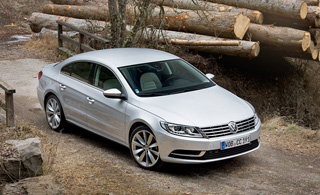
The previous Passat CC could be ordered with a sport packet R-line-with a more aggressive body kit, a reconfigured suspension and a special decoration of the cabin. For the new one, nothing similar has been provided yet.
The base engine 1.8, of course, is also worthy. He loses a little bit of a two-liter counterpart in dynamics and tormenting, but the difference in dynamics is still felt. Especially in the version with mechanics with somewhat stretched gear rates.
But what about diesel?
Of the diesel engines, it was possible to travel only on a 140-horsepower version of a two-liter turbodiesel engine with a mechanical transmission. A pleasant engine: it pulls well, literally, with idle, although more recently, it was not easy to move on Volkswagen diesel engines due to a lack of traction at the beginning of the working range, and cheerfully spins up to 4.5-5 thousand revolutions per minute. In the pluses of 320 nm of torque and ridiculous fuel consumption of 5.4 liters per hundred kilometers in a mixed cycle, and in the disadvantages of excessive vibration load.
In Europe, this motor is available in two versions simply TDI and Bluetdi with urea injection, and both of them meet Euro-6 standards, which enter into force two years later. But for Russia, all motors, including gasoline, sharpened under Euro-5, will simplify to Euro-4 norms.
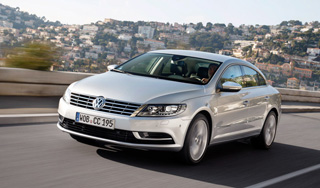
On diesel engines, the DSG transmission opens both clutches when moving - to save fuel. In addition, all Passat CC modifications are able to disconnect the generator on the acceleration, additionally reducing CO2 emissions and fuel consumption. But no installations of stop start or energy recovery for the TSE-TEC is provided.
O'Kay, what about prices?
In Russia, Passat CC is already sold. The basic version with 1.8 and mechanics costs 1 million 108 thousand rubles by 57 thousand rubles more than to restyling, and 68 thousand rubles more than a regular Passat with the same engine. A robotic transmission will increase the price of 95 thousand rubles.
Two-liter versions of the TSE-TEC gasoline and diesel, complete with DSG, cost 1.444 and 1.433 million rubles, respectively. The flagship 3.6 with all -wheel drive will cost an impressive amount of 1.981 million rubles. Having such money in hand, you can look, for example, at the Audi A5 Sportback Hatchback with a 211-horsepower turbo engine (from 1.848 million rubles).
Why Audi, maybe it's better just a passat?
If we talk about the basic version, then in some ways, perhaps better. It is more practical, more familiar, more familiar, but in the case of 210-horsepower versions not everything is so simple: Passat CC with such a motor costs 100 thousand rubles cheaper just a passat in a very similar configuration. The diesel also comes out a little cheaper, and an ordinary sedan with a 3.6 engine and all -wheel drive in Russia is not sold at all.
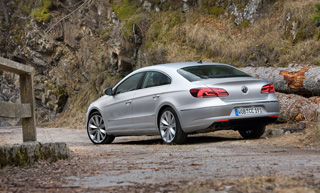
In other markets - in the USA and Europe - this car is now called just Volkswagen CC. However, in Russia, Passat was decided to leave the Passat prefix. For solidity?
But another thing is important: Passat CC, even after restyling, remains the most beautiful folkswagen of our time. Elegant, stylish, with a good interior, doors without a framework and light with a shade of premium. For which, by the way, you can overpay a little.
Alternative
Audi A5 Sportback Stylish Audi hatchback is more expensive - prices for it are just starting from 1.554 million rubles. But for 1.88 million you can buy an all-wheel drive car with a robot and a 211-horsepower turbo engine, which develops 350 nm of torque on Audi models, instead of 280 on Volkswagen.
Citroen DS5 pseudo -universal from Citroen with a fantastic design in Russia has not yet been sold - we will only appear by the summer of this year. Therefore, there are no prices yet. In Europe (in Germany), such a car can be bought a little cheaper than 30 thousand euros: among its advantages - a luxurious interior, good turbo engines, as well as the presence of a hybrid version.
Volvo S60 VOLVO sedan - the only one in this class can claim the title of image. The basic price for a version with a 1.6 (150 forces) turbo engine starts from a mark of 1 million 99 thousand rubles, and an all-wheel drive car with a 304-horsepower V6 turbo engine will cost at least 1.964 million rubles.
Source: Motor magazine [March 2012]

